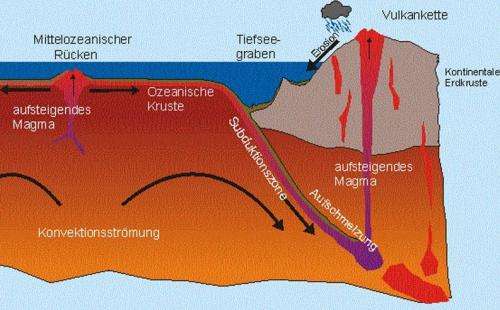The Atlantic 'resting' -- for now

Geophysicists have simulated when the continents around the Atlantic develop active continental margins with earthquakes and volcanoes. According to the model, ‘real’ fully active subduction zones will not form for another twenty million years at the earliest.
Oceanic trenches, earthquakes, mountains and volcanoes arise through the subduction of tectonic plates. These phenomena shape the renowned Pacific Ring of Fire around the Pacific. Along this ring, oceanic crust sinks beneath the continental margins while new oceanic crust is constantly formed on the mid-ocean ridge. The process of subduction sets in once the oceanic crust is several tens of millions of years old and has cooled down to such an extent that it has a higher density than the area of the earth’s mantle beneath it, namely the asthenosphere. Consequently, it sinks beneath the adjacent continent more or less by itself. In the world’s oceans, there is thus hardly any oceanic crust that is older than about 170 million years.
Active means earthquakes and volcanoes
Compared to the Pacific, things are much quieter in the Atlantic: it would seem that the oceanic lithospheric plate – oceanic crust with part of the upper mantle – has not begun to sink along the margins of the Atlantic yet. However, computer models suggest that subduction can also start without the hallmark features, such as volcanic activity or the formation of trenches. Using computer simulations, an international team of scientists under the direction of ETH Zurich has now examined whether this is true of the Atlantic – in other words, when and where in the Atlantic the process could start.
The researchers’ simulations, conducted under the direction of Taras Gerya, a professor at ETH Zurich’s Institute of Geophysics, suggest that the continental margins of North America will continue to remain stable for tens of millions of years – provided the parameters used in the models do not change and no unforeseeable circumstances interfere. However, changes in the crust that could accelerate the onset of subduction have already been recorded by other scientists. The current models especially yield new evidence and findings for South America.
According to the models, it will probably take another four million years for the continental crust of the coast of southern Brazil to gradually push itself over the oceanic crust. Only in twenty million years will the oceanic plate gradually sink; and after twenty-five million years the continental and oceanic plates will have separated from one another – a subduction zone will have formed.
The Atlantic coast of North and South America offered the scientists ideal prerequisites for the simulations as the conditions that favour subduction vary greatly there – like the tectonic forces exerted by mountain ranges such as the Appalachians in North America or the Brazilian Plateau, for instance. The researchers factored the topography and structure of the crusts and the upper mantle into their simulations. Moreover, they also took the prevalent density ratios in each of them, the progress of the boundary between the crust and mantle, which is referred to as ‘Moho’, and the temperature into account. ‘The temperature governs the strength of the lower crust and the upper mantle,’ says Gerya.
But the large-scale forces of the mid-ocean ridge that pull through the oceans bordering the Americas also influence the subduction process: the constantly growing oceanic crust of the Atlantic pushes to the west, the crust of the Pacific to the east. This all combines with a thin continental lithosphere under the coast of southern Brazil which, compared to its oceanic counterpart, is less strong. The bond holding the two tectonic plates therefore breaks there first and the continental crust begins to push itself over the gradually sinking oceanic crust.
Weak spot due to thin lithosphere
The scientists cut the South American continent into five horizontal sections. The computer simulations, which were determined using the profile data available, show that, with a continental lithosphere that’s 125 to 150 kilometres thick, the northern part of South America will remain stable for at least another fifty million years. ‘The plate boundaries off the southern section of Brazil, however, are marked by a very thin lithosphere,’ says Gerya. There, the thickness of the lithosphere is only about seventy-five kilometres and the temperature at the Moho is very high (735 degrees Celsius) that dramatically reduces strength of the lower crust and the upper mantle. The models therefore suggest that a subduction zone will probably develop along the southernmost American Atlantic first. However, it will take another twenty-five million years for this to be able to compete with an established subduction zone as in the Pacific Ring of Fire.
More information: Nikolaeva K, Gerya TV & Fernando Marques FO: Numerical analysis of subduction initiation risk along the Atlantic American passive margins, Geology (2011), 5; 463-466; DOI: 10.1130/G31972.1
Provided by ETH Zurich

















